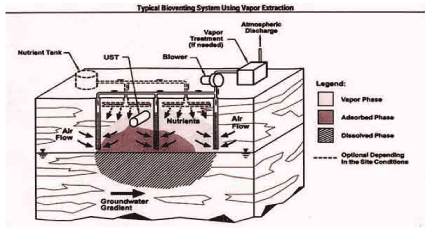

| |
|||||
| Applicability | |||||
|
|||||
|
|||||
|
|||||
| Biosparging Biosparging, like bioventing, is an in situ remediation technique that supplies oxygen and nutrients (if needed) to contaminated soils to promote aerobic biodegradation of contaminants (i.e. petroleum hydrocarbons) by indigenous microorganisms. However, biosparging is not confined to the unsaturated zone, but rather extends remediation to the saturated zone of the soil matrix. It can be used to lower concentrations of petroleum constituents dissolved in groundwater and the capillary fringe, or adsorbed to soil particles residing below the water table. |
|||||
Biosparging is often used in conjunction with soil vacuum extraction or bioventing. Biosparging uses sparging wells to pump air into the saturated zone to increase biodegradative processes. Its design is similar to that of soil vacuum extraction or air sparging systems; however, as in the case of bioventing, air flow in biosparging is induced at slower rates in order to enhance aerobic biodegradation and minimize volatilization. The placement and frequency of these sparging wells is determined largely by the intrinsic permeability and structure of the soil. Correct placement of sparging wells can be calculated by using the radius of influence (ROI). By definition, the ROI is the maximum distance from a sparging well at which sufficient sparge pressure and airflow can be induced to enhance the biodegradation of contaminants. |
|||||
 |
|||||
| Figure 1.5 Typical Biosparging System (used with soil vapor extraction) | |||||
| Bioaugmentation Though soil systems naturally contain a diversity of microorganisms, one particular bacterial species needed for biodegradation is sometimes absent from the contaminated site. Fortunately, bacteria can be cultured in the laboratory and introduced into the soil matrix. This introduction of non-native microbial species for the enhancement of microbial activity is referred to as bioaugmentation. In addition, bioaugmentation often requires the introduction of an electron acceptor (i.e. oxygen) and nutrients. |
|||||

